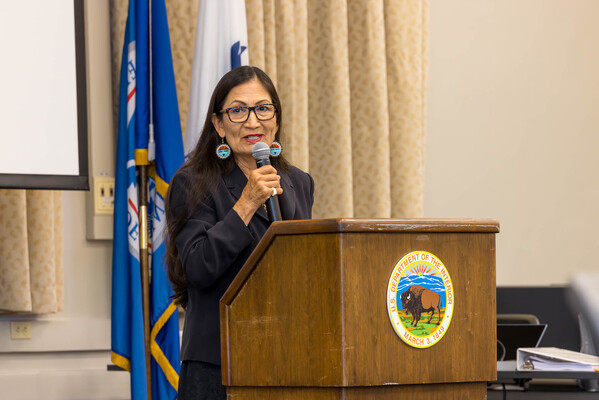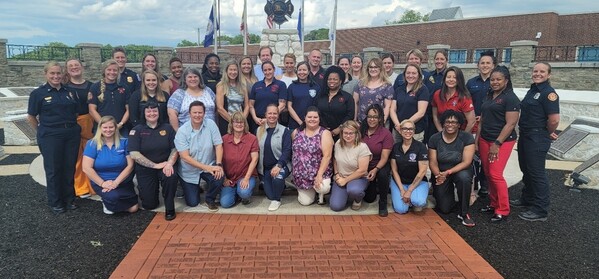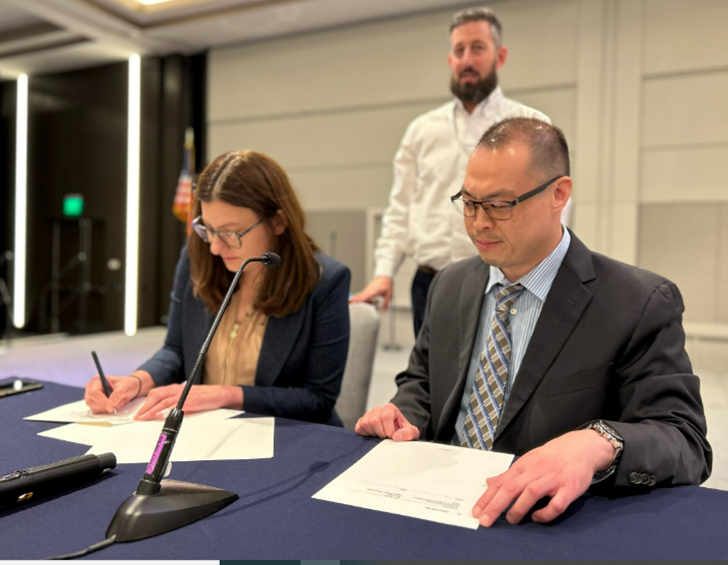|
June 21-23, the Wildfire Mitigation and Management Commission held an in-person meeting at the National Emergency Training Center (NETC) in Emmitsburg, Md. Participants included senior leadership from FEMA, the U.S. Fire Administration, the Department of Interior and the United States Department of Agriculture.
FEMA Administrator Deane Criswell and U.S. Fire Administrator Dr. Lori Moore Merrell welcomed commission members to the NETC campus. Dr. Elizabeth Sherwood, Homeland Security Advisor to President Biden, addressed commission members, recognizing wildfires as a threat to national security. President’s Homeland Security Advisor Dr. Elizabeth Sherwood-Randall thanked the commission members for their important work addressing wildfires by identifying potential solutions and making recommendations.
The commission was tasked with writing two reports for the U.S. Congress. The Aviation report was released on Feb. 13 and outlined a strategy to meet aerial firefighting equipment needs through 2030.
The second report, to be completed by September 2023, will compile findings about the growing risk of wildfires. It will also provide recommendations on actionable solutions to enhance landscape and community resilience, support fire-adapted communities, and enable safe and effective response to future wildfires.

Last month, the U.S. Fire Administration’s National Fire Academy partnered with Women in Fire to host the first-ever Women’s Weekend at the National Emergency Training Center.
More than 200 attendees from 32 states and the District of Columbia participated in the weekend’s training courses and activities. The attendees were both career and volunteer fire and EMS personnel, including fire chiefs, firefighters, firefighter paramedics, paramedics, fire investigators to community risk reduction specialists and more.
The weekend began with a session presented by U.S. Fire Administrator Dr. Lori Moore-Merrell on Friday night, followed by trainings on Saturday and Sunday.
Attendees took time during the training weekend to honor the fallen. Deputy Chief Khalilah Yancey from Baltimore City Fire and Deputy Chief Tiffany Wesley from Arlington County Fire, both members of the Women in Fire leadership team, placed a wreath at the memorial. The ceremony was followed by the traditional 5-5-5 tolling of the bell honoring our commitment to never forget.
The National Fire Academy plans to host Women’s Weekend again in 2024. Visit National Fire Academy (fema.gov) for updates.

FEMA will host the first in a series of webinars on Wednesday, July 12 to celebrate the 2023 FEMA Partnership Reimagined. The series will celebrate the power of collaborative relationships in emergency management. This provides an opportunity for FEMA, National Voluntary Organizations Active in Disaster (National VOAD), and other non-government organization partners to engage with each other and enhance the mutual understanding of disaster assistance resources, capabilities and mechanisms. This series expands upon previous years’ Partnership Month initiatives to give more opportunities for collaboration.
The initial webinar will provide an overview of FEMA’s Public Assistance program resources for private non-profits while future events and programing on other FEMA resources will be announced in the coming weeks.
The webinar, co-hosted by FEMA’s Voluntary Agency Liaisons and the DHS Center for Faith-Based and Neighborhood Partnerships, covers:
- How the Public Assistance program supports houses of worship and private non-profits in times of disaster.
- How to apply for Public Assistance grant funding.
- Lessons learned when applying for Public Assistance grant funding.
- Best practices and lessons learned from Public Assistance program representatives and national nonprofit partners.
Date: Wednesday, July 12, 2023
Time: 2 - 3:30 p.m. ET
Location: ZOOM (Please use this link to register).
Meeting ID: 161 811 8921
Passcode: VOISE
Closed Captioning ID: 11398
Log in to closed captioning at the event’s start time, by clicking on this link.
Learn more about FEMA’s Public Assistance Program:
FEMA Public Assistance: Private Nonprofit Organizations
Public Assistance Applicant Quick Guide
Assistance for Governments and Private Non-Profits After a Disaster | FEMA.gov
FEMA published nine Hazard Mitigation resource typing documents. The collection includes two National Incident Management System (NIMS)-typed Hazard Mitigation teams for operations and planning and seven positions that make up the Hazard Mitigation teams.
FEMA assembled a stakeholder group comprised of subject-matter experts from federal, state, local and non-governmental entities to review the existing resource types. These efforts resulted in the creation of three new positions and updates to the existing positions and teams that incorporate the latest best practices in hazard mitigation.
The new and updated positions include:
- NIMS Type 2 Hazard Mitigation Planner.
- NIMS Type 1 or 2 Hazard Mitigation Risk Analyst.
- NIMS Type 2 Hazard Mitigation Outreach Specialist.
- NIMS Type 1 Hazard Mitigation Floodplain Management Specialist.
- NIMS Type 2 Hazard Mitigation Building Code Specialist.
- NIMS Type 1 Environmental and Historic Preservation (EHP) Historic Preservation Specialist.
- NIMS Type 1 EHP Environmental Specialist.
- NIMS Type 1 Hazard Mitigation Engineering and Architect Specialist.
- NIMS Type 1 Public Assistance/Infrastructure Mitigation Specialist.
- NIMS Type 1 Construction Cost Estimator.
FEMA releases these resource typing documents to enhance the interoperability and effectiveness of mutual aid by establishing baseline qualifications for Hazard Mitigation NIMS-typed teams and personnel. This facilitates the sharing of deployable resources at all jurisdictional levels.
These documents can be accessed in the Resource Typing Library Tool.
On July 11, FEMA announced the group of dedicated young people who will participate in the Youth Preparedness Council (YPC) for the 2023-2024 term.
The council consists of student leaders in grades 8-11 who devote their time and effort to learn about emergency management and serve as preparedness ambassadors in their community. Members are chosen based on their dedication to public service, community involvement and potential to increase levels of community resilience throughout the country.
The 2023-2024 National Youth Preparedness Council Members are:
- Jordy Almonte of New York.
- Armaan Bhasin of Wisconsin.
- Georgia Bukata of Arizona.
- Arushi Gupta of California.
- Michael Hamad of Texas.
- Diego Irizarry Ramos of Puerto Rico.
- Bryce Ludikhuize of Wyoming.
- Anjali Mukundan of Virginia.
- Ysabella Olsen of Missouri.
- Iris-Bella Quiroa of Rhode Island.
- Kennedy Solaru of Washington, D.C.
- Suniti Srinivasan of Washington.
- Julia Surzykiewicz of Illinois.
- Isabella Tarsitano of Florida.
- Jiaming Zhang of Oregon.
These 15 youth leaders will spend a year on the council supporting FEMA’s commitment to promoting and sustaining a prepared nation. The council provides FEMA with an avenue to engage young people and gain direct insights on ways to consider their perspectives, feedback and opinions.
While on the council, national YPC members meet with FEMA staff to provide input on strategies, initiatives, and projects. Serving on the council helps forge new relationships and provides members with valuable professional skills as they develop preparedness-related projects.
The council was formed in 2012 to bring together youth leaders from across the country engaged in advocating for preparedness. For more information, visit FEMA.gov.
On June 29, an official Memorandum of Understanding was signed between FEMA and the National Community Emergency Response Teams (CERT) Association during the annual conference for the CERT community in San Francisco, Calif.
The memorandum serves as a renewal of FEMA’s commitment to support the CERT program – a nationally supported, locally implemented initiative that teaches people how to better prepare themselves for hazards that may affect their communities.
FEMA Associate Administrator for the Office of Response and Recovery, Anne Bink, delivered the keynote address. In her address, she discussed current FEMA public preparedness initiatives including the #SummerReady campaign and this year’s National Preparedness Month focus on older adults.
Bink also recognized six individual CERT members working in Illinois, Florida, Texas, Pennsylvania and California for their long hours and dedicated service.
FEMA’s Individual and Community Preparedness Division coordinated additional events and trainings throughout the conference. The division provided more than 200 copies of CERT training materials in Traditional Chinese and Spanish to ensure the courses and graduation ceremonies provided during the conference were available to all participants.
 From left to right: Associate Administrator for the Office of Response and Recovery Anne Bink and CERT President Suu-Va Tai signing an official Memorandum of Understanding.
In accordance with the Community Disaster Resilience Zone Act of 2022, FEMA must use a data and mapping tool to identify and designate community disaster resilience zones. This new initiative aims to identify high-risk geographic zones and provide focused financial and technical support to advance resilience in our nation’s most vulnerable communities.
FEMA facilitates multiple avenues for gathering feedback, including listening sessions for states, Tribes, territories, local communities, public and private sector entities, and non-profit organizations. These sessions and the Request for Information published in the Federal Register offer opportunities for public input. FEMA seeks public input on risk methodology, designation of zones, and post-designation support for each zone.
FEMA scheduled four interactive listening sessions for July and August 2023. Each session can accommodate a maximum of 1,000 participants. All opportunities will be conducted online via Zoom and recorded with a transcript of each session to be published on FEMA’s website for easy access and reference.
Register for sessions using the links below:
Risk Assessment Methodology and the Method to Designate Community Disaster Resilience Zones
This session will be offered twice:
Tuesday, July 18, 2 – 3:30 p.m. ET. Register here.
Wednesday, July 19, 2 – 3:30 p.m. ET. Register here.
Frameworks for Delivery Services and Technical Assistance to Designated Zones
Thursday, July 20, 2 – 3:30 p.m. ET. Register here.
Additionally, FEMA has scheduled a specific consultation on this topic for tribal nations to discuss how best to include Tribal Lands in zone designations, use of census data, and strategies to communicate designation of zones to tribal nations from 3-4:30 p.m. ET on Aug. 2. For additional information, including the agenda and to register, visit the Tribal Consultations webpage on FEMA.gov.
FEMA joins industry partners and stakeholders for the annual National Access and Functional Needs Symposium, from noon to 3 p.m. ET, July 11 -12.
The annual online event brings the disability community together with emergency managers, disaster planners and first responders to highlight forward-leaning, inclusive, innovative practices in emergency management.
FEMA Disability Coordinator and Office of Disability Integration and Coordination Director Sherman Gillums, Jr. will present a keynote address focusing on how partnerships and accessible design can create life-saving resiliency.
“When the structural environment acknowledges and empowers all members of a community, resiliency is achieved through the dignity and independence shared by those members, regardless of how they carry out everyday life functions,” says Gillums. “Preparedness becomes the most effective first response to disasters through universally designed and enabled communities.”
Topics for this year’s panels include:
Planning for Successful Emergency Evacuation Outcomes
Empowering local jurisdictions and people with access and functional needs to develop comprehensive, inclusive emergency evacuation plans that work for the whole community.
Emergency Communication – Alerts, Warnings and Notifications for Everyone
Not everyone in the community receives or processes information the same way. Emergency managers, communication experts, and advocates outline the strategies and best practices for reaching everyone in the community.
Making Everyone Welcome – Establishing Physically and Programmatically Accessible Shelters
Successful sheltering requires more than being able to physically access the site. It also means including the accessible cots, handwashing stations, portable restrooms, showers, dietary considerations, personal care services, and wrap-around services needed to make it accessible.
Climate Change – An Existential Threat with Disproportionate Impacts on the Whole Community
Officials discuss the realities of climate change, the increased devastation associated with today’s disasters, and its disproportionate impact on people with access and functional needs.
The symposium is organized by the California Governor’s Office of Emergency Services, International Association of Emergency Managers, Colorado Division of Homeland Security and Emergency Management, and New York University.
Register to the National AFM Symposium here.
FEMA recently launched a survey for Building Resilient Infrastructure Investment and Community (BRIC) stakeholders.
The survey results help inform continuous improvement of the BRIC program and offers benefits to process improvements across FEMA’s Hazard Mitigation Assistance grant programs.
The survey asks participants about their experiences with all aspects of the BRIC grant program—from project development to submitting grant applications— in order to help enable FEMA to better meet stakeholder needs in the future.
FEMA will conduct an in-depth analysis of all feedback and publish a summary report with the findings in 2024. The agency hopes to gain valuable insights from feedback to inform continuous improvement of the BRIC program and benefit process improvements across FEMA’s Hazard Mitigation Assistance grant programs.
By addressing challenges and streamlining processes, FEMA strives to make accessing BRIC funding more accessible and efficient for its stakeholders.
The deadline for all submissions is Wednesday, Aug. 16.
Visit FEMA.gov or Survey Monkey to take the survey.
Application Period Open for the National Dam Safety Program State Assistant Grant
FEMA announced that the Fiscal Year 2023 National Dam Safety Program, State Assistance Grants funding opportunity is published in Grants.gov. The application period will close July 21.
The National Dam Safety Program helpline is available 9 a.m. - 5 p.m. ET, Monday - Friday. For questions, email FEMA-NDSP-HHPDGrants@fema.dhs.gov. For more information, visit FEMA's Dam Safety webpage. For more information about the National Dam Safety Program, visit FEMA.gov.
…………………………………………………………………………………………………………..
$12M Available for Regional Catastrophic Preparedness Grants
FEMA released the funding notice for the Fiscal Year 2023 Regional Catastrophic Preparedness Grant Program. The program provides $12 million to eligible states and local governments to close known preparedness capability gaps, encourage innovative regional solutions to issues related to catastrophic incidents and build on existing regional preparedness efforts.
Awards will be made on a competitive basis to applicants who present an ability to successfully meet the requirements described in the funding notice.
The application period will remain open until 5 p.m. ET on July 24. Submissions must be made through Grants.gov. The Notice of Funding Opportunity is available on Grants.gov as well as on FEMA.gov.
…………………………………………………………………………………………………………..
FEMA Seeks Comments About Increased Funding Access and Reducing Disaster Risk
FEMA published a notice in the Federal Register seeking public comment on how to apply new legislation that will designate areas with communities most at risk and from natural hazards. The comment period is open until July 25.
This notice is for the agency to gain better understanding in key areas that will support an effective implementation of the Community Disaster Resilience Zone Act. FEMA posted the Request for Information to learn the best ways to obtain public feedback that will help shape and inform how the agency uses the act to increase resilience efforts.
Comments can be submitted from 2023-11268 on the Federal eRulemaking Portal, Docket ID: FEMA-2023-0009 or by emailing FEMA-CDRZ-RFI@fema.dhs.gov. Please follow the instructions on the page for submitting comments and contact the Regulations.gov Help Desk if you have technical issues.
Visit FEMA.gov for more information
…………………………………………………………………………………………………………..
FEMA Announces Training Grants on Rural Community Preparedness and Increasing Tribal Capacity Building
On June 22, FEMA released the funding notice for $6 million in competitive grants as part of the Fiscal Year 2023 Homeland Security National Training Program/Competitive Continuing Training Grants. These grants provide training solutions to address specific national preparedness gaps and increased capacity through training availability.
This year, for the first time, FEMA designed the grant with two distinct focus areas, "Build Tribal Capacities to Improve Readiness and Resilience" and "Rural Preparedness for Equitable Outcomes."
The funding notice is posted at Grants.gov, at DHS-23-NPD-005-00-96. Grants are available to applicants through a competitive process to help improve the nation’s ability to respond to and recover from all-hazards events through training. The application period will close at 5 p.m. ET on Aug. 7.
|